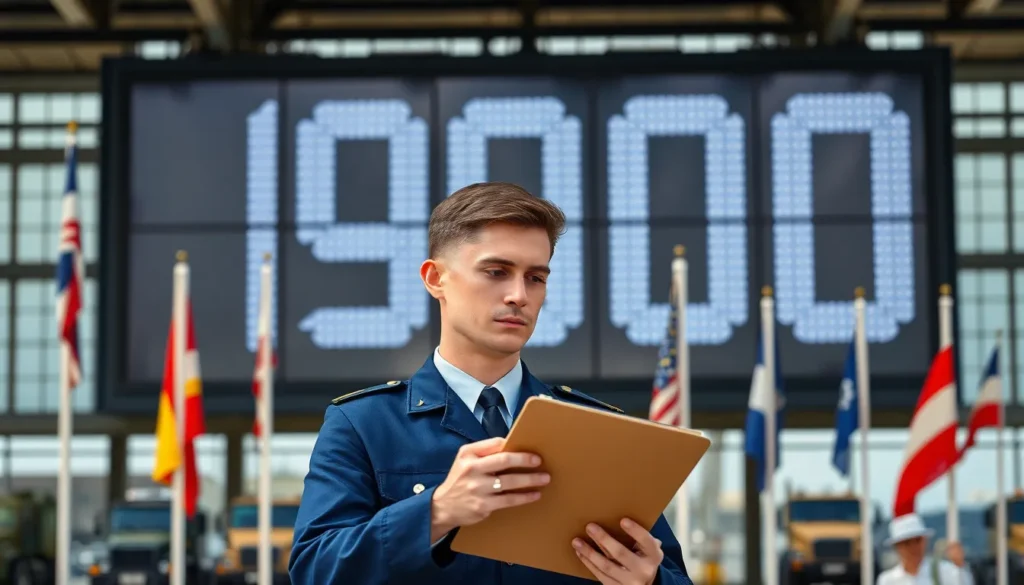Table of Contents
ToggleWhen the clock strikes 7 PM, most people think of dinner, relaxation, or maybe even their favorite TV show. But in the military, it’s a whole different ballgame. Instead of cozying up with a plate of pasta, they’re using a 24-hour clock that might just make your head spin faster than a drill sergeant on caffeine.
Understanding Military Time
Military time uses a 24-hour format, eliminating AM and PM designations. This system starts at midnight, labeled as 0000, and continues until 2359, with each hour represented in hours and minutes. For example, 1:00 PM converts to 1300 in military time.
Converting standard time to military time involves adding 12 to PM hours, except for 12 PM, which remains the same. Conversely, AM hours from 1:00 AM to 11:00 AM remain unchanged in the conversion. Familiarity with this format aids in clear communication, essential for military operations.
Individuals may find military time beneficial in scheduling and efficiency. By using this format, he or she can avoid confusion, particularly when coordinating activities across different time zones. This clarity helps personnel in high-pressure situations where quick decision-making is crucial.
Understanding military time strengthens collaboration, especially in mixed environments with civilians. Educational programs and practice can enhance comfort with military time formats. Such training often includes interactive exercises to reinforce learning and ensure retention.
Resources like online converters and charts assist those grappling with this timekeeping system. Frequent exposure to military time in daily contexts can promote easier adaptation. By grasping this system, individuals can enhance their time management skills and ensure effective communication.
Converting Standard Time to Military Time

Converting standard time to military time requires a basic understanding of the 24-hour clock system. Military time starts at midnight, labeled as 0000, and counts upward until 2359.
The Basics of Military Time
Military time eliminates the AM and PM designations, providing clarity in communication. For instance, 1:00 PM translates to 1300 hours, while 7:00 PM converts to 1900 hours. Knowing this system can enhance time management in various scenarios. Since military time aligns with a 24-hour format, it reduces ambiguity, making it ideal for operations where every minute counts.
Conversion Chart Overview
A conversion chart simplifies understanding of military time. Below is a brief overview:
| Standard Time | Military Time |
|---|---|
| 12:00 AM | 0000 |
| 1:00 AM | 0100 |
| 12:00 PM | 1200 |
| 7:00 PM | 1900 |
| 11:59 PM | 2359 |
This chart provides quick reference points for converting various times. Familiarizing with it aids in better navigation of military schedules and improved coordination.
The Significance of 7 PM in Military Time
Understanding 7 PM in military time provides essential clarity in various settings. This time translates to 1900 hours, emphasizing the importance of accurate timekeeping in military operations.
How to Read Military Time
Reading military time requires familiarity with the 24-hour clock. Starting from midnight, hours progress sequentially, reaching 1900 for 7 PM. For example, the conversion from standard time to military time shifts 1 PM to 1300 hours. Learning the numbers makes interpretation straightforward, ensuring precise scheduling. Those unfamiliar with this system can benefit from a conversion chart, simplifying the reading process.
Practical Applications of 7 PM in Military Time
Utilizing 7 PM in military time has practical implications in the field. This specific hour often aligns with crucial briefings or operational transitions. Coordinating tasks around 1900 facilitates efficiency among service members, particularly in diverse environments with various time zones. Moreover, ensuring everyone understands this conversion minimizes the risk of operational misunderstandings. Military leaders prioritize clear communication to maintain mission effectiveness, making knowledge of military time indispensable.
Common Misconceptions About Military Time
Confusion often arises regarding military time, largely due to the 24-hour clock format. Many believe military time is complicated, but it’s actually straightforward with practice. The elimination of AM and PM designations can mislead those who are unfamiliar with this system, leading to an assumption that it’s difficult to learn.
Some people assume that military time uses different hours for different regions. In reality, military time operates on universal time across all branches, maintaining consistency for coordination. Misinterpretation of hours also occurs; for example, 1900 hours might be mistakenly thought of as 7:00 AM instead of 7:00 PM.
Another common belief is that military time is solely for the armed forces. It’s widely used in various industries, including healthcare, transportation, and travel. Professionals in these fields rely on military time to enhance communication and reduce errors.
Experts note that converting standard time to military time is simple. Adding 12 to PM hours efficiently creates intervals; thus, 7 PM becomes 1900 hours. Clear understanding reduces chances of confusion, especially in high-stakes environments.
Finally, many think learning military time requires extensive effort. In fact, a few basic rules suffice for mastering the format. Resources like conversion charts can further ease the learning curve, providing quick reference points for the standard time to military time conversion.
Understanding military time is crucial for effective communication in various settings. Recognizing that 7 PM translates to 1900 hours highlights the importance of precision in timekeeping. This knowledge not only aids military personnel but also benefits those in industries like healthcare and transportation.
By familiarizing oneself with the 24-hour clock format, individuals can enhance their scheduling efficiency and minimize misunderstandings. Embracing military time fosters better collaboration across diverse environments. With practice and the right resources, anyone can master this straightforward system, ensuring clear and effective communication.







